By Bill Yenne
When I was a young boy in Seattle, my father told me about a fake town that had been built on top of Boeing’s Plant 2 during the war. This naturally fired my imagination. What an ingenious way, I thought, to fool the enemy bombers that might being coming over the Emerald City to wreak havoc. He told me about it with exaggerated caution to underscore the fact that it had been top secret during the war. Nobody was supposed to talk about it, although everyone in town knew about this faux neighborhood that employees called “Wonderland.” By the time people in the know were allowed to talk about Boeing Wonderland, the company was tearing it down.
Wonderland was kept out of the newspapers until the war was almost over, but it was an open secret. Just as “Loose Lips Sank Ships,” loose lips could also bring Mitsubishi G4Ms swarming over that little neighborhood on East Marginal Way South. (Read more about the audacious plots used to foil Axis powers inside WWII History magazine.)
Indeed, the entire monumental effort made to camouflage West Coast aircraft factories was an open secret. Tens of thousands of men and women went to work beneath bogus villages every day, quietly assuming that it was a vital necessity that was serving to protect their lives. At the same time, they knew that they dare not mention it.
In retrospect, we know that during World War II, enemy bombers never clouded the skies over any American city—except Honolulu, of course. In retrospect, too, we know a lot about what might have happened, but did not, during the war. At that time, though, it was not so obvious that Japanese bombers would never appear.
People living on the West Coast were not convinced that this could not, and would not, happen. Pearl Harbor is nearly 4,000 miles from Japan. If the enemy could launch a large-scale air raid in two waves on Honolulu and environs, what was stopping them from doing the same, also without warning, against any city from San Diego to Seattle?
The War Approaches the West Coast
Within a month of the attack on Pearl Harbor, the Japanese had captured Manila and Hong Kong. Singapore fell about a month after that. The West Coast was jittery and very afraid. In 1942, nobody went anywhere near a beach without looking long and hard toward the horizon, half expecting to see a Japanese invasion fleet.
Few persons in authority were more shaken by the dread of a Japanese invasion than General John Lesesne DeWitt, the commander of the Fourth U.S. Army and the Western Defense Command, who imagined spies and saboteurs under every bush and used his overactive imagination to justify his draconian enforcement of Executive Order 9066, which led to the internment of all Japanese American civilians—including those born in the United States—who lived in the West Coast states.
The nervous DeWitt even ordered that the 1942 Rose Bowl Game be relocated away from Pasadena for fear that the Japanese would bomb the venue. His biggest fear, though, was what a Japanese invasion might do to his career. He knew the troops under his command were entirely inadequate to meet a force such as the enemy had just used to invade and conquer the Philippines.
He was not alone in his concern. On February 23, the Japanese submarine I-17 shelled oil storage facilities about 10 miles up the coast from Santa Barbara, California. The following night, nervous gunners thought they saw an armada of Japanese bombers over Los Angeles, and the sky was illuminated with searchlights and exploding antiaircraft shells.
The people in the City of Angels had seen the newsreels of the London Blitz, and they knew that the Luftwaffe had leveled cities from Rotterdam to Coventry. Of course, they were well aware of what had happened in Hawaii in December. There was little reason not to believe that California’s Southland was getting its turn.
The government, specifically Navy Secretary Frank Knox, announced that the “Battle of Los Angeles” was a “false alarm,” and there is no evidence that it was not. However, even at the time, many people assumed that sinister government obfuscation was in motion. Today, the Battle of Los Angeles “cover-up” still rates its own small cadre of true believers whenever conspiracy theorists congregate.
Even if Los Angeles was a false alarm, Santa Barbara really happened. Then, just as those who had held their breath got up the nerve to exhale, the Japanese submarine I-25 attacked Fort Stevens in Washington state on two consecutive nights in June. Also in June, Japanese forces invaded and occupied the Aleutian islands of Kisksa and Attu, establishing a Japanese base on Alaska’s doorstep.
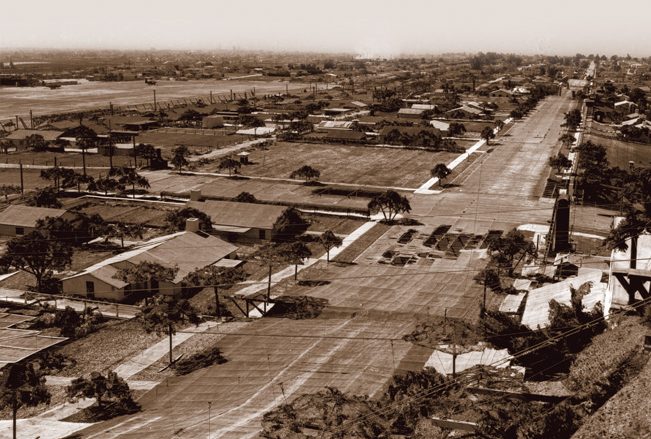
Meanwhile, a number of American merchant ships were being sunk off the West Coast of the United States. Attacks also came from the air. In September, Nobuo Fujita flew two bombing missions over southwestern Oregon in a submarine-launched Yokosuka E14Y floatplane.
These are the events that actually did happen. For each of these, there were a hundred widely believed rumors that are not chronicled in the history books, but which governed the perceptions of those who lived with them in the midst of mankind’s biggest war. It was a frightening moment in U.S. history.
These events, real and imagined, defined the apprehensive mood of the home front in 1942. The Axis armies seemed invulnerable abroad, and the West Coast felt too dreadfully exposed, especially to air attack.
Everyone—from the military planners at the War Department to the civilians on the street gazing nervously at the sky—knew that World War II was an air war. It was the first war in which air power played an essential role, and air power was proving itself to be a prominent and devastating weapon.
The National Defense Advisory Commission
Just as the enemy, especially the Luftwaffe, was wielding air power so effectively, military and industrial planners in the United States understood that America’s own aircraft production must be the highest of priorities.
In the spring of 1940, more than a year before Pearl Harbor, President Franklin Roosevelt had famously proclaimed that America should have 50,000 combat aircraft. Between them, the Navy and the Army Air Corps had less than a fifth that number, and most of these were trainers. To assure that the services had enough airplanes, production had to be ramped up. Aircraft factories suddenly became the most vital element in American defense procurement and in Roosevelt’s emergency mobilization of essential industries.
In May 1940, the administration created the National Defense Advisory Commission to oversee this industrial expansion, and Congress authorized funds for both the expansion of existing factories and construction of new facilities that would be government-owned and managed by a new bureaucracy known as the Defense Plant Corporation but operated by existing manufacturers.
To head this commission and to serve as commissioner of production, Roosevelt tapped William Signius “Big Bill” Knudsen. An expert on mass production and auto industry executive, Knudsen had been president of General Motors since 1937.
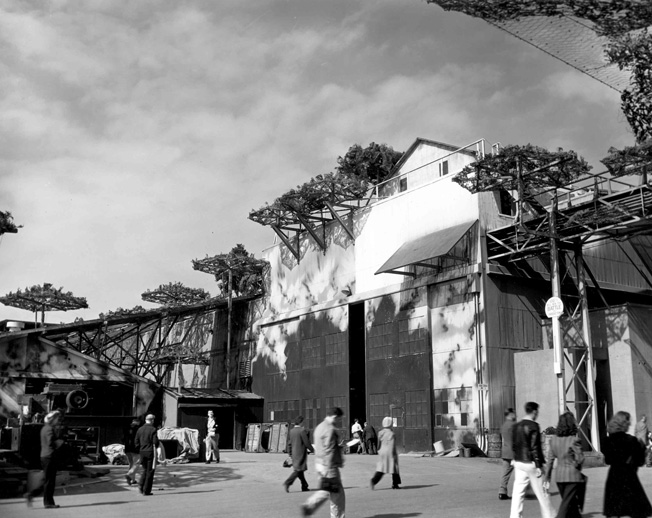
In 1940, nearly 90 percent of airframe manufacturing capacity measured in square feet of floor space was located in five states, with 65 percent along or near one of the coasts; California alone had 44 percent.
Of America’s five largest aircraft manufacturers by total aircraft weight, four—Douglas, Consolidated Vultee (with plants in San Diego and Downey), North American, and Lockheed—were located in Southern California, with their factories within five minutes flying time of the Pacific Ocean. The fifth, Boeing, was only about 100 miles inland from the Pacific in Seattle. On the East Coast, meanwhile, Grumman, Martin, and Republic were all closer to the Atlantic than Boeing was to the Pacific. Of the major American aircraft manufacturers, only Curtiss and Bell, in upstate New York, had their flagship factories more than an hour from the coast.
In the wake of Pearl Harbor, Roosevelt and Knudsen realized that they had been right. America’s plane-making infrastructure was dangerously vulnerable. If the same carrier battle group that had zeroed in upon Pearl Harbor had been sitting 200 miles off the Malibu coast, Douglas, Consolidated Vultee, North American, and Lockheed would be out of business for months—or longer. They also realized that Japanese planners knew this as well.
The new Defense Plant Corporation factories were being built well inland, in states such as Illinois, Michigan, Missouri, and Texas, but in the dark days of early 1942, most of the industry was still exposed to the potential of enemy attack. Because everyone now had a graphic illustration of what could and did happen, protecting this vital manufacturing infrastructure was an even bigger priority than it had been on December 6.
Enter Major John Francis Ohmer, Jr., a man with a plan at a time when a plan was needed.
John Ohmer, Jr.’s Camouflage Scheme
Born in Dayton, Ohio, in 1891, he was the son of John Francis Ohmer, Sr., an inventor, manufacturer and founder of the Ohmer Fare Register Company. Young John earned his masters degree in engineering from Cornell University in 1913, and served with the U.S. Army’s 404th Engineer Battalion in World War I. He later returned to the family business but retained captain’s rank in the Engineer Officers Reserve Corps.
Ohmer, an amateur magician and a photography hobbyist, also began to develop an interest in both the art and the science of camouflage. In 1938, he formed the 604th Engineer Battalion as a camouflage unit within the California-based Fourth Army.
Studying the success of the Royal Air Force in camouflaging their fighter fields from the Luftwaffe during the Battle of Britain in 1940, Ohmer proposed the same to the U.S. Army Air Corps (renamed U.S. Army Air Forces after June 1941).
He even carried out some demonstrations of suggested camouflage techniques at places such as Fort Eustis, Virginia, and such air bases as Langley Field, Virginia, and Maxwell Field, Alabama. However, prewar budgets were tight, and there was no money for operational camouflage.
In March 1941, Ohmer was ordered back to active duty as a major under the command of the office of the Chief of Engineers, Operations and Training Section, in Washington, D.C. That fall he was sent to Hawaii to study defenses. He recommended an extensive camouflage plan for Wheeler Field on Oahu, about 12 miles north of Pearl Harbor. The cost of the project, around $50,000, was too much for the USAAF, and it declined. A few weeks later, on December 7, the USAAF lost most of its Wheeler-based aircraft to the same raiders that decimated Pearl Harbor.
By this time, Major Ohmer was based at the USAAF’s March Field in California’s Riverside County, east of Los Angeles. Against a backdrop of fear and revamped priorities, General DeWitt ordered Ohmer to develop a camouflage plan for the West Coast. Ohmer, who had done a lot of thinking about a project such as this, found himself with a dream assignment.
With money no longer an object, the amateur magician implemented his well-considered plan to make California’s aircraft industry vanish. He began with March Field itself, using it as a demonstration project, an operational training exercise to work out specific techniques and technical details.
Tapping Hollywood’s Talent
Ohmer’s proximity to Hollywood gave him access to an incredible pool of talent in the form of the best movie set designers and large-scale scenic painters in the world. Meanwhile, all the major studios were more than willing to provide their services for the war effort. Ohmer had his pick of the best talent at Columbia, Disney, Metro-Goldwyn-Mayer, Paramount, Twentieth Century Fox, Universal Studios, and others.
“In the early weeks of 1942, March Field came alive with creative talent,” writes Dr. Dennis Casey of the Air Intelligence Agency (now Air Force Intelligence, Surveillance and Reconnaissance Agency). “Indeed, some Army observers remarked that it looked like a Hollywood studio back lot.
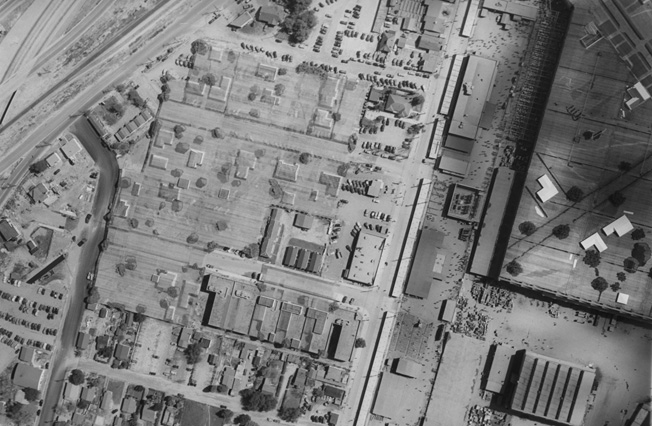
“Depending on where you might walk, you could run into a small farm being created complete with animals, a barn, a silo and other buildings. Pastoral settings were under construction using frames of lumber and large spreads of canvas. When a pastoral setting was used to conceal an ammunition storage area, the whole thing achieved near reality when a neighboring farmer grazed his cows near the phony buildings.”
According to Casey, Ohmer and his team disguised 34 military air bases in Washington, Oregon, and California, as well as Mills Field, the future San Francisco International Airport.
Their most dramatic attention, however, was reserved for the Southern California aircraft manufacturers, including Lockheed in Burbank, North American Aviation in Inglewood, Northrop in Hawthorne, and Consolidated Vultee in Downey.
The idea was to make the aircraft factories “disappear” by cloaking them to appear as innocuous suburban neighborhoods to an observer flying at an altitude of 5,000 feet. Operational bombing altitudes were generally higher, although the attacks on Pearl Harbor had come in much lower.
Ohmer’s Villages Two-Dimensional Villages
The disguises consisted of painting what appeared to be streets and greenery on real runways, and erecting entire faux subdivisions on factory rooftops. Standard-issue camouflage netting, stretched on massive wooden scaffolding served as the basic canvas on which the Hollywood artists painted contrasting color detailing to suggest streets and other features. The netting was foliage green to begin with, but areas were sprayed in subtly different shades to give the scene a more realistic look. Some “lawns” in the subdivisions were painted brown to suggest that they had not been watered.
Dozens of fake houses, as well as schools and public buildings, were made of canvas. Hundreds of artificial shrubs and other ground details were created, using burlap over chicken wire matrices.
The movie industry illusionists developed a method of crafting trees using tar and feathers. Chicken wire was lightly coated with tar, and then dipped in chicken feathers. The finished product, which had a soft, leafy appearance, could be formed into a rigid structure of any shape and sprayed multiple shades of green.
Chimneys and vents in the roofs of the factory buildings were allowed to poke through the netting, and were painted to simulate fireplugs.
In Burbank, full-size inflated rubber “automobiles” were parked on the “streets” above Lockheed’s plant (where the Bob Hope Airport is located today), and workers went up periodically to move them around from place to place to suggest that they were being driven and reparked. In some cases, clothing was even taken on and off real clotheslines that were installed behind the houses. In the event Japanese reconnaissance aircraft were secretly overflying Southern California, Ohmer’s team wanted to give their fantasy world a lived-in look.
Ohmer’s villages were as accurate as possible in two dimensions, although not in height. The houses and trees were not very tall; indeed, most of the buildings were no taller than six feet. The reason was that the camouflage was designed to be seen from high above, not from ground level, and to be studied in minute detail only in the form of two-dimensional aerial photographs. In practice, a bombardier would have no more than two minutes, if that, to view the target, and he would be looking straight down.
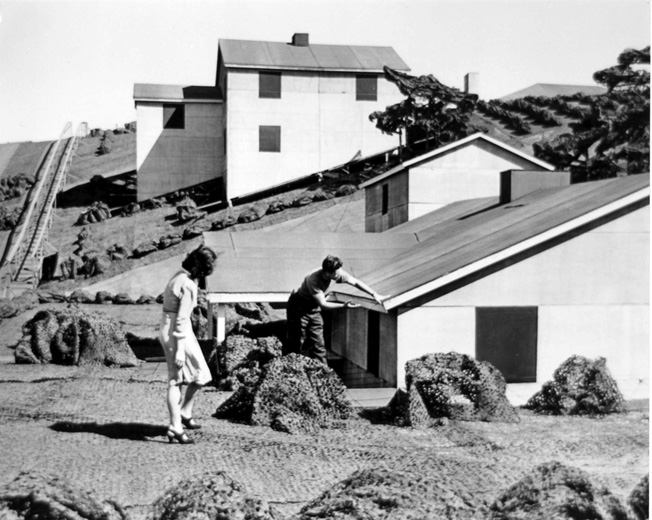
“Ohmer’s camouflage works by deceptively combining a technological feature of photography with one of its contingent social meanings,” writes Austin Nelson in a March 2012 blog post on the Camera Club of New York website. “On the one hand, Ohmer’s work took advantage of a fundamental technological truth about the camera, namely that it’s mono-focal.
“Photographed objects are rendered in perspective but by a single lens and onto a flat 2D surface. The effect is that the space around and between things looks squashed, especially in cases like aerial shots where the depth of field is very shallow. At the same time for Ohmer’s paintings to work as camouflage when photographed, he had to assume that despite the apparent unreal flatness of any aerial photograph with a shallow depth of field, the enemy still believed in the literal truth of such photographs….
“If Ohmer could count on the Japanese’s [sic] belief in the literal truth of photography (and the very existence of their aerial reconnaissance program would have given him reason to do so), he could reliably use the flattening effect of photography to his advantage. That is, as long as the Japanese expected aerial photographs of on-the-ground reality to look flat no matter what, that ‘reality’ could be simulated with an equally flat painted canvas. Ohmer added some three-dimensional props to his tarps, like shrubs and rubber cars, but these were accents to a painted picture that had to be convincing in its own right.”
Nevertheless, the overall terrain of the “landscape” was not flat. In order to compensate for the irregular height of various factory buildings, the subdivisions appeared at ground level to have been built on gently rolling hills.
In a lecture that he delivered to military personnel on September 15, 1943, Ohmer, now a colonel, described his technique as “visual misinformation.”
H. Roy Kelley and Edward Huntsman-Trout: Donald Douglas’s Magicians
Meanwhile, when it came to visual misinformation, John Ohmer’s was not the only game in town. Donald Douglas, whose Douglas Aircraft Company operated plants at Santa Monica, El Segundo, and Long Beach, had decided not to wait for the Army Engineers. In 1941, Douglas had asked engineer Frank Collbaum to find him someone who could design a plan to camouflage the Douglas Aircraft flagship plant at Clover Field in Santa Monica. Collbaum, whose history at Douglas included his having been the flight engineer on the debut flight of the immortal DC-3, suggested the noted architect, H. Roy Kelley.
Among his many other accomplishments, Kelley is credited with having been an originator of mid-century California “ranch-style” homes, some of which were represented in faux form in the enormous rooftop commission that he undertook for Douglas in 1942. On this project, Kelley teamed up with an equally popular and well-known California landscape architect, Edward Huntsman-Trout, whose credits included the campus of Scripps College in Claremont.
Like Ohmer, Kelley and Huntsman-Trout utilized Hollywood set designers, specifically from Warner Brothers, in their project. According to Cecilia Rasmussen of the Los Angeles Times, their creation was made of “burlap supported by a tension compression structure of more than five million square feet of chicken wire and 400 poles.” It covered the terminal and hangars, as well as the parking lot.
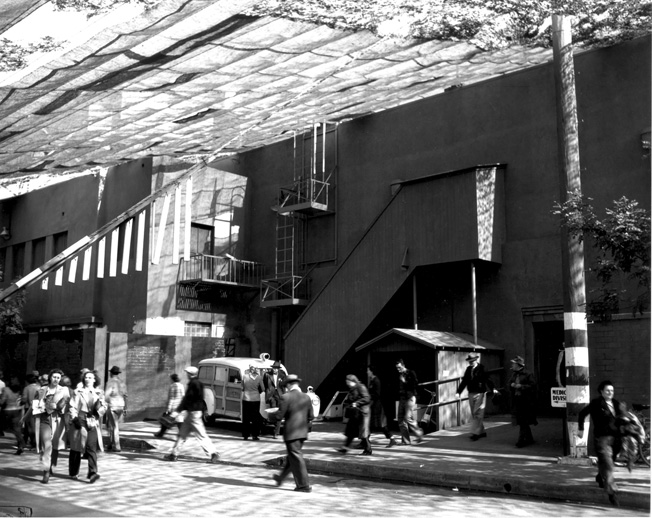
As Ohmer’s own Hollywood experts had done, they filled their “village” with houses, fences, and clotheslines. In turn, they designed their “street grid” so that it blended into the adjacent Sunset Park neighborhood. They even matched the scale of their “ranch” homes to match those in Sunset Park. Warner Brothers executives later insisted that their own lot receive the “Kelley Treatment.” They decided that their sound stages looked too much like aircraft hangers from the air, and feared that Japanese bombardiers, fooled by the Clover Field camouflage—or by Lockheed’s, only three miles to the north—would bomb their studio instead!
The Santa Monica camouflage was so effective that American pilots who were supposed to land at Clover Field occasionally got lost and had to divert to alternate airports. For a time, Douglas adopted a policy of placing men waving red flags at the ends of the runways to greet incoming planes.
Transforming Boeing’s Plant 2
In Seattle, Boeing’s president Philip Johnson followed suit with Don Douglas, moving quickly to protect his principal asset—Plant 2. On December 11, four days after Pearl Harbor, the company issued a press release tersely reporting that Plant 2 had been “entirely transformed from a daylight plant to a blackout plant, enabling all night operations during blackouts. This plant is believed to be one of the first, if not the first, major defense plant in the country to complete this transformation.”
On April 1, 1942, the Boeing News Bureau reported with a bit more colorful detail that “the suddenness of the Pearl Harbor attack and the urgency it created prevented wasting of any time in laying groundwork for the work of blacking out. Painters, janitors, maintenance men—all available nonproduction workmen who had painting experience—were quickly rounded up and added to a crew furnished by Austin Construction Company. Brushes, spray guns, all necessary equipment was rounded up, too. All equipment, including pressure tanks and hoses, was hauled to the roof by hand…. Wartime censorship rules do not permit revealing of the plant’s size or the number of windows painted in those two days and nights, but the number of windows was tremendous, and approximately four miles of air hose were used for operating spray guns.”
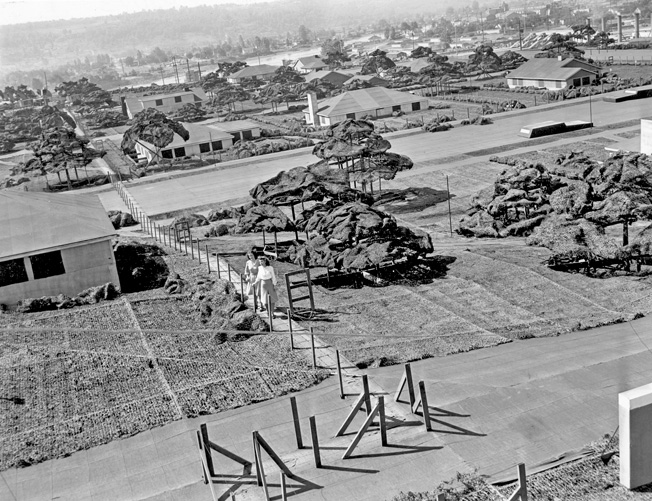
It was actually harder than it sounds. The crews had to experiment with five different paints before they found a mixture that would stick to the windows. When done, the black windows created a reflection problem and had to be painted over with gray to match the rest of the building. Finally, Austin Construction installed three layers of plywood inside the windows to protect workers from shards of glass that might be shattered by bomb blasts. It would have been easier just to replace the glass with plywood.
John Detlie’s Designs in Seattle
In May 1942, the Corps of Engineers undertook to camouflage the blacked-out factory. To design the job, Ohmer sent John Stewart Detlie, a talented art director whom he had recruited off the Metro-Goldwyn-Mayer lot. Having earned his degree in architecture from the University of Pennsylvania in 1933, Detlie went to Hollywood to start a career in set design. In 1940, he was nominated for an Academy Award for his work on MGM’s Bitter Sweet, with Jeanette MacDonald and Nelson Eddy.
In 1940, the 32-year-old Detlie married an 18-year-old starlet named Constance Ockelman. Within a year, Constance had become one of the hottest talents in Hollywood, and had changed her name to Veronica Lake. Detlie was living the Hollywood dream—until Ohmer came calling.
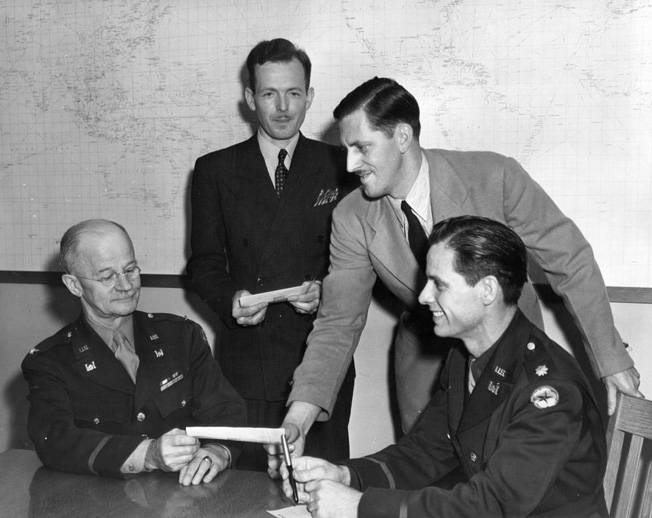
As Veronica Lake became one of the favorite GI pinup girls of World War II, her husband reported for duty in Seattle. Detlie found an environment where the Japanese occupation of islands near Alaska was of particular concern. Seattle was 900 air miles from Juneau, the capital of the future 49th state. People in the Pacific Northwest readily imagined that when the other shoe dropped, they would be next.
My father, who was working at the Todd Pacific shipyard on Seattle’s Harbor Island—about three miles north of Boeing Field—recalls being called to work in the middle of the night on June 3, 1942. A Japanese radio transmission had been intercepted. Enemy bombers were on their way to Harbor Island!
The Todd Pacific workers battened down the hatches and waited for the air raid. Finally the “all-clear” sounded. The Japanese had bombed Dutch Harbor, Alaska, instead of Harbor Island, Washington. The radio intercept was misinterpreted. Still, Alaska was too close for comfort.
While my father was welding superstructures for Fletcher-class destroyers, John Detlie was a few miles away, working with Washington State Camouflage Director William James Bain and the Seattle architectural firm of Young and Richardson to hide Boeing from Japanese aircraft. They designed an elaborate camouflage plan that included a rooftop covering for Plant 2, as well as fake streets and foliage detail that would be painted across Boeing Field.
The “streets” that began on the roof of Plant 2 continued across the runway and climbed the slopes of Beacon Hill, on the opposite side of the field where Interstate 5 is now located. The latter was accomplished by cutting the paths through the brush on the hillsides that looked like streets.
Boeing Wonderland
The focal point of Detlie’s effort, his large-scale masterpiece, was the 26 acres atop Plant 2. Here, the crews supervised by the Seattle District of the Army Corps of Engineers, were presented the challenge of a “sawtooth,” rather than flat, roof. This uneven surface, stepping up and down with a variation of as much as 35 feet, necessitated scaffolding, platforms, and framing that consumed an estimated million board feet of Pacific Northwest lumber, as well as an elaborate sprinkler system to protect it from fire, accidental or caused by the enemy. In addition, the structure consumed 555 tons of steel structures and half a million feet of support wires.
Because of the variation in the height of structures below, there were several fairly steep “hills” in Detlie’s “Wonderland.” This imaginary town had at least three major streets, as well as alleys and driveways. The streets even had names. Though there was no way that a bomber pilot could read street signs from 10,000 feet, the people who built Boeing Wonderland had senses of humor and couldn’t resist; Synthetic Street intersected Burlap Boulevard.
Using the “tar and feathers” method also seen in Southern California, the engineers created some 300 artificial trees, some of them as tall as 12 feet. There were a total of 53 homes, two dozen garages, three greenhouses, a small store, and even a gas station. All of them were built of wood and canvas like those which John Ohmer had designed in California.
Many were only about four feet high at the eaves, although some were taller, and there were even a few which represented two-story houses. Inside, they were furnished only with fire-protection sprinklers. Mile-long catwalks served as “sidewalks” and provided access to all the areas of Boeing Wonderland.
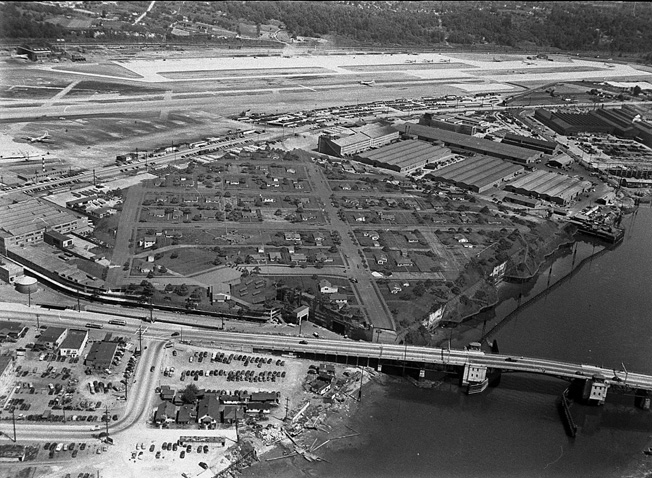
At least two of these homes were built to be occupied by nonimaginary people. During 1942 and early 1943, the U.S. Army personnel who manned antiaircraft guns in Wonderland were housed on the Plant 2 rooftop.
Whereas the imaginary populations of the imaginary rooftop towns in Southern California “drove” rubber cars, the automobiles parked on Wonderland’s streets were made of wood and were just a couple of feet high. The angular design of these wood frame vehicles made them look more like AMC Gremlins from the 1970s than the smoothly rounded Fords and Chevies of the 1940s.
An often-repeated urban legend was that a cow was even let loose to roam Boeing’s Wonderland. However, this charming but improbable story has just as often been debunked by those in the know.
Passive and Active Defenses
Also involved in building and maintaining the elaborate camouflage project at Plant 2, Boeing Field, and Beacon Hill, were the personnel of the Passive Defense Division of the Corps of Engineers. Indeed, the Seattle office of the division was quite active during the war. LeRoy Robert Hansen, chief of the division’s Agronomy Section, who was probably involved in the Boeing project, published his 1943 monograph, The Use of Grasses and Legumes for Camouflage and Dust Control on Airfields with a Seattle dateline.
Different techniques were used for the sections of the phony village that were laid out across Boeing Field. As described by the Seattle District Engineers, the “problem was to obtain a texture to which camouflage paint would adhere and yet which would offer no interference to air traffic. After much experimenting, a crushed rock surface from one-eighth to three-eighths of an inch was rolled with an adhesive material for paved areas. For nontraffic areas, wood chips or hogged [sic] fuel with cement was used.”
In the areas between and beyond the runways, the “houses” were merely concrete slabs six inches thick, because anything higher was deemed to constitute too much clutter for ramp and runway operations. However, in these areas, “lawns” and vacant lots could be comprised of real grass and real weeds, carefully designed and tended by LeRoy Hansen’s agronomists.
While Detlie and the engineers managed the passive defense for Boeing, active defense, such as the planning and execution of fire and air raid drills and air raid shelters, was handled by company personnel, such as Glenn V. Dierst, the company’s plant protection manager, and his team of white-helmeted wardens. A 1943 Boeing News Bureau release states that all the plant personnel could reach the shelters in less than 12 minutes.
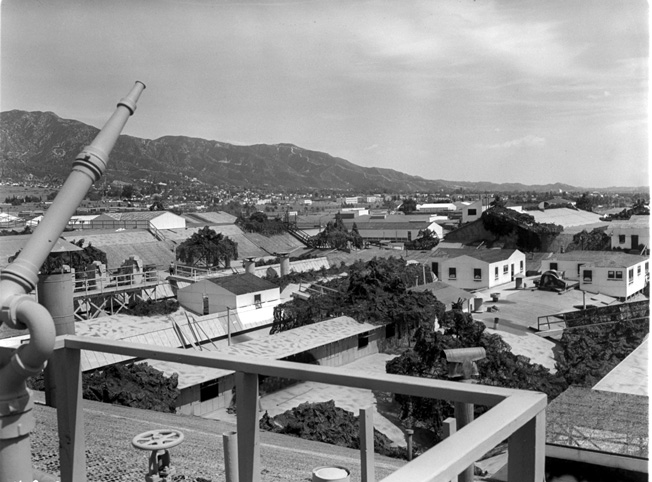
Seattle presented a unique problem for the passive defense planners. As anyone who has gazed at the ground from an airplane has noted, it is much easier to identify a familiar location through the contrasting color and contours of land and water. New York and San Francisco, for example, are easier to recognize than Des Moines or Topeka because their shapes are strictly defined by rivers and bays. Because Seattle is sandwiched between the distinctively shaped Puget Sound and Lake Washington, spotting landmarks is easier than it is at Burbank.
For this reason, Detlie planned additional phases for the Boeing project. His master plan involved overhead camouflaging of the large Boeing employee parking lots, as had been done at the Lockheed and Douglas employee lots in California, as well as continuing the camouflage cover across sections of East Marginal Way.
Because the Boeing campus is defined geographically by the Duwamish River that flowed behind Plant 2, Detlie conceived of covering it as well and painting a faux river that had a different course in the vicinity of the Boeing facility. A further phase that was also seriously considered by the Corps of Engineers involved the construction of an entire dummy aircraft factory at a different location, complete with fake airplanes.
The Missing Photographs of Boeing Wonderland
While the Japanese never came, there are many tales of American pilots who had used the pre-war Boeing Field who were now confused by the camouflage and the absence of familiar landmarks. Indeed, with the field covered by scattered clouds, it was quite hard to make it out from the air.
Unless a pilot had gained actual experience with the camouflaged field, it was hard to know what to expect because no aerial photographs were published until the second half of 1945.
For a 1987 article in Seattle’s The Weekly, journalist Tom Watson spoke with Vern Manion, who worked as a photographer for the in-house paper, Boeing News. In 1943, he had been asked to take aerial photographs of Plant 2 so that the camouflage could be evaluated by the brass in Washington, D.C. He shot a couple of rolls from an open-cockpit Stearman and landed back at Boeing Field only to discover that one of his rolls was missing!
The aircraft was searched, then disassembled and searched. The roll had apparently fallen out somewhere over the field. An extensive search for the small object came up empty handed.
“The FBI questioned me for weeks,” Manion told Watson. “They were real worried.”
Finally cleared of suspicion of espionage, Manion went on to complete four decades of service to the company. The film never turned up. By early 1945, ground level photographs of Plant 2 had been published, but the public had yet to see any aerial photographs.
The Secret Cities Revealed
Meanwhile, the personal life of John Stewart Detlie was unraveling. His marriage to superstar Veronica Lake ended three months after her pregnancy was tragically terminated when she tripped and fell on the set of a movie she was making.
Detlie never went back to the film industry and did not return to California for two decades. After the war, he married Virginia Crowell and became a prominent Seattle architect, designing several landmark buildings at the University of Washington, as well as the Children’s Orthopedic Hospital. When Detlie lost a second young child—three-year-old Christopher Detlie died in 1960—the architect and his wife left Seattle permanently. After time spent in Hawaii and Baltimore, they settled in Southern California.
Detlie’s plan for “rerouting” the Duwamish River was never implemented, nor indeed were any further camouflage projects after 1943. By that time, the Japanese were on the defensive and had been routed from the Aleutian Islands. The likelihood of an attack had greatly diminished. The fear and apprehension of 1942 gradually faded to nervousness, and the nervousness faded to complacency.
Nevertheless, the open secret of the existence of all those rooftop villages in Seattle and Southern California remained unheralded. Indeed, it was not until the summer of 1945 that the admittedly transparent cloak of secrecy was officially taken down. A release by the Boeing News Bureau dated June 19, 1945, stated, “Today’s word and picture description of the elaborate Boeing camouflage job, made with the approval of the Western Defense Command, was the first public pronouncement on the subject.”
On July 17, nearly a month before the Japanese government announced that it was ready to surrender unconditionally to the Allies, the Army Corps of Engineers announced that it had already issued contracts to civilian firms to dismantle the hoax hamlets. Among others, the L.B. Colton Company of Los Angeles had been awarded $248,861 to dismantle Detlie’s Seattle Wonderland within 150 days. The Corps of Engineers press release put the cost of installing the Boeing camouflage project at $2 million, although a June 27, 1945, article in Boeing News estimated $2 million for Boeing Field and another million for Plant 2.
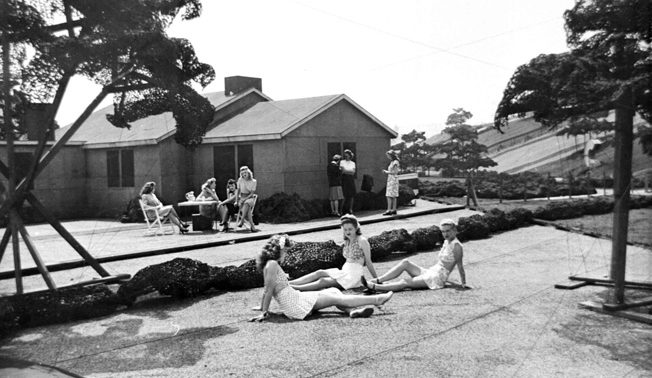
Both Boeing and Douglas made a photo op of the official revelations, sending groups of women employees to their respective villages to be photographed by company photographers. The idea was to show the young women strolling and picnicking as they might in any average American suburb. These pictures appeared in the July 26 issue of Boeing News and the September issues of Douglas Airview and Boeing Magazine even as crews were moving in to tear down those tranquil appearing villages.
These few carefree photo sessions were just about the only occasions when anyone had the opportunity to spend any time photographing these mystery towns at eye level. A few months earlier and it would have been a criminal offense. A few months later, and there was nothing left to photograph!
Gone But Not Forgotten
By the end of 1945, the blackout paint had been stripped from the factories up and down the coast, and John Francis Ohmer had joined John Stewart Detlie in hanging up his uniform for the last time. By the end of 1946, the last vestiges of the gargantuan West Coast camouflage scheme had been removed.
They were gone, removed in their entirety, but they have never been forgotten. Even Mike Lombardi, Boeing’s corporate historian, continues to be amazed by the enduring fascination that the public, and even Boeing personnel, have with the hoax hamlets.
As he told me, “with nearly one hundred years of great airplanes, one would think that the most frequently asked questions directed to the Boeing history office would be about the B-17, the 314 Clipper, the 707, or 747, but hands down the most popular subject is the ‘neighborhood on top of Plant 2.’ To this day, the size, scope, and imagination of that project still captivate and amaze the public and employees.”
These amazing villages, which almost certainly were never even seen by Japanese recon pilots, disappeared virtually overnight, vanishing like mirages. But they continue to live on in our collective memory of the American home front of World War II.
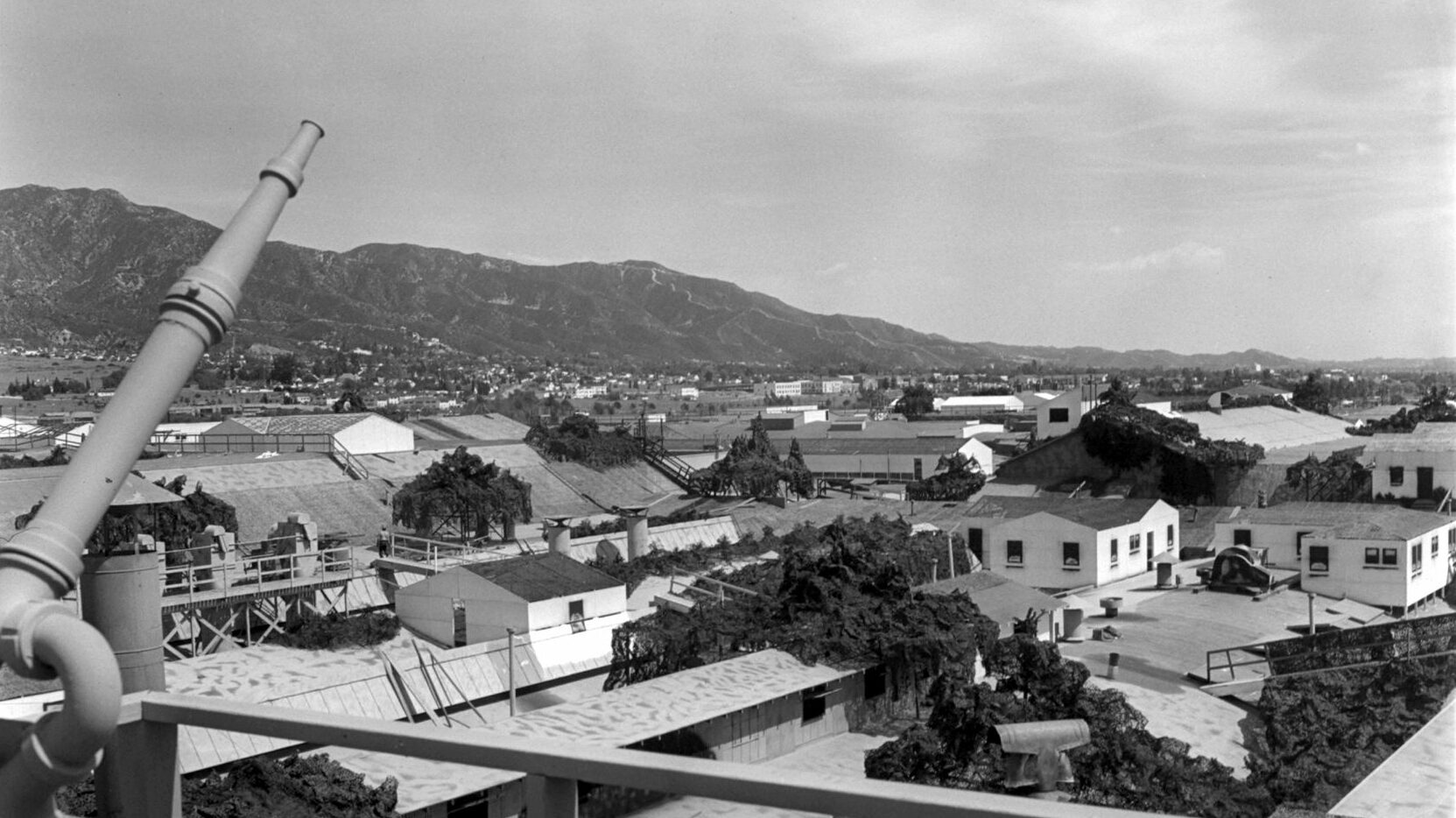
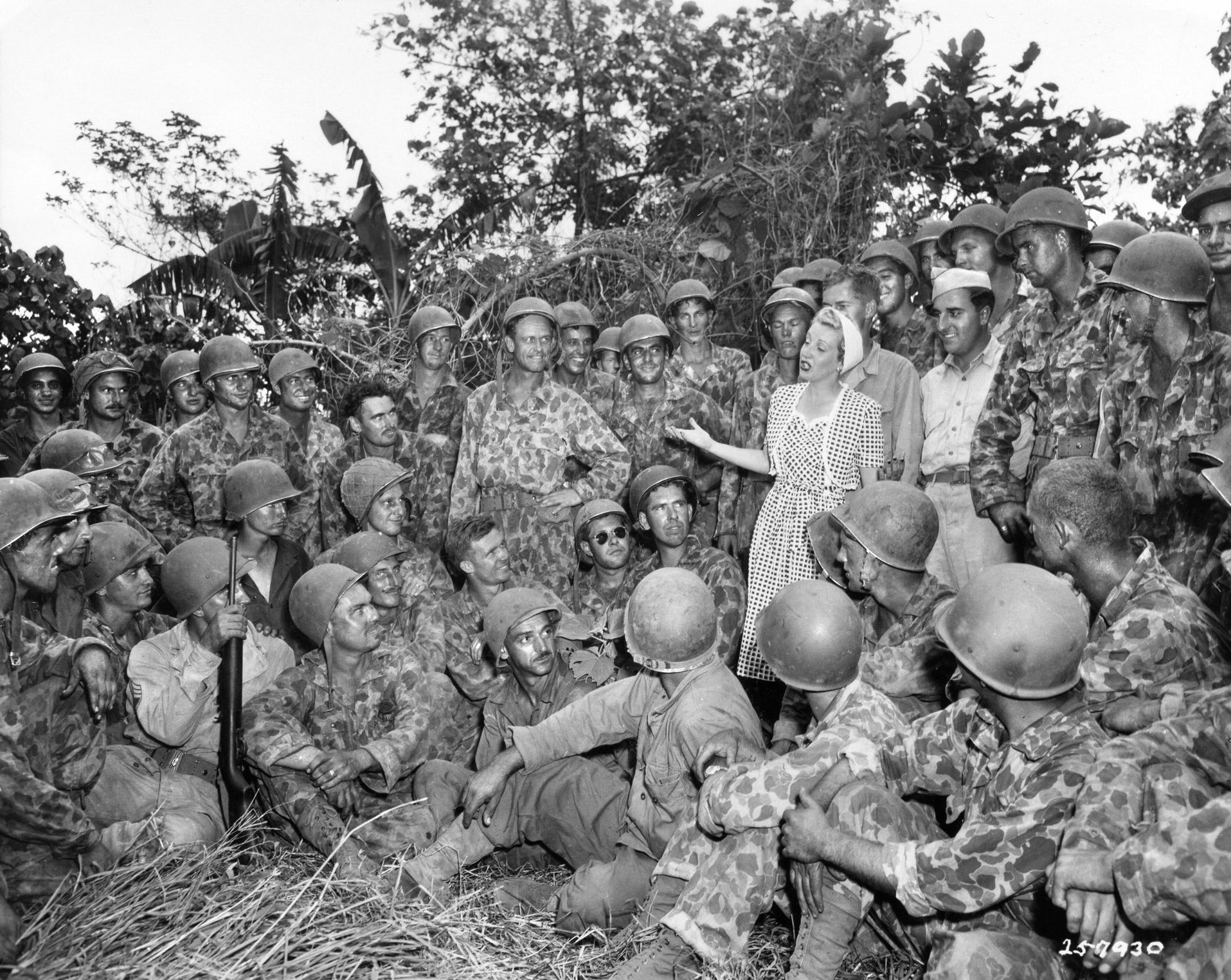
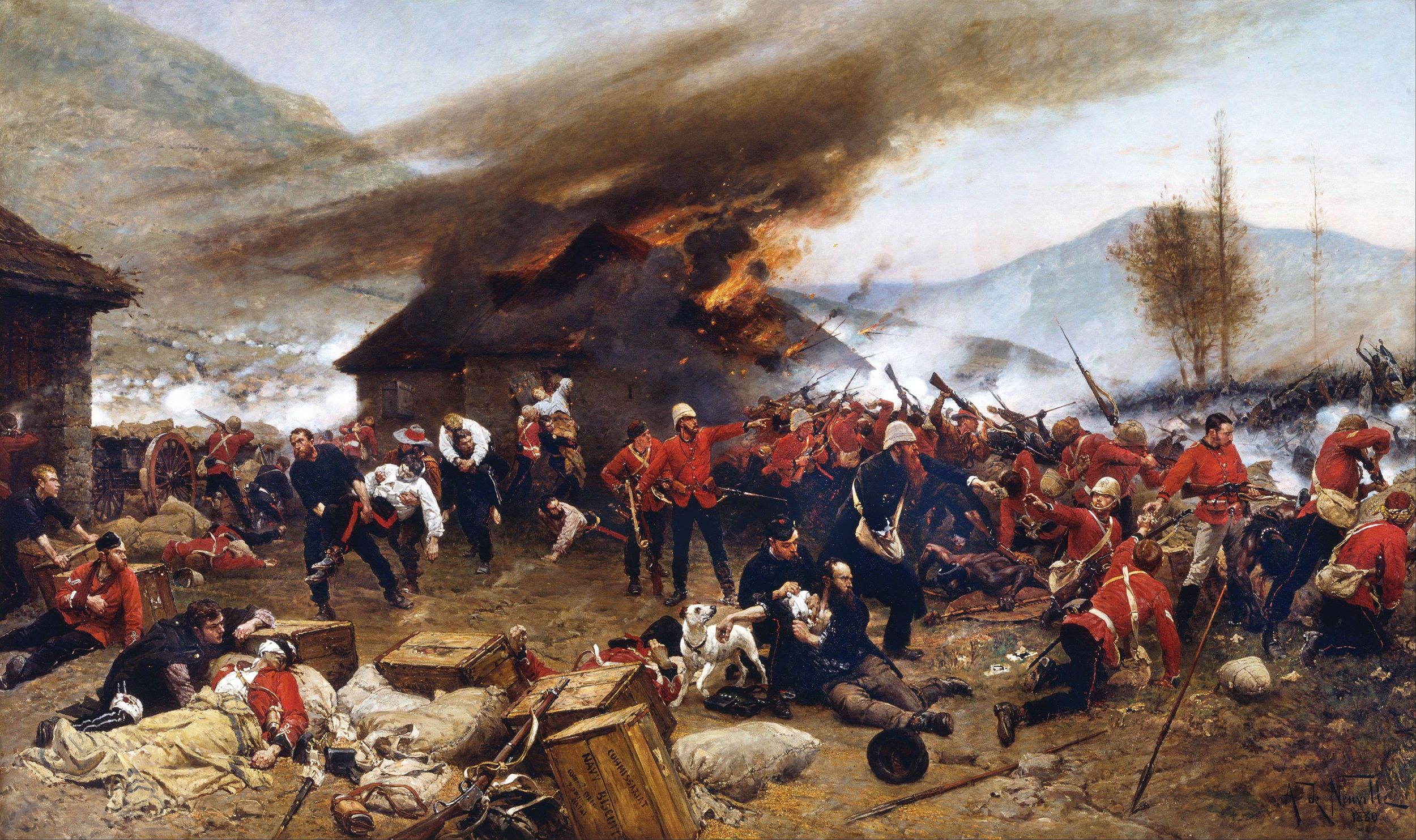

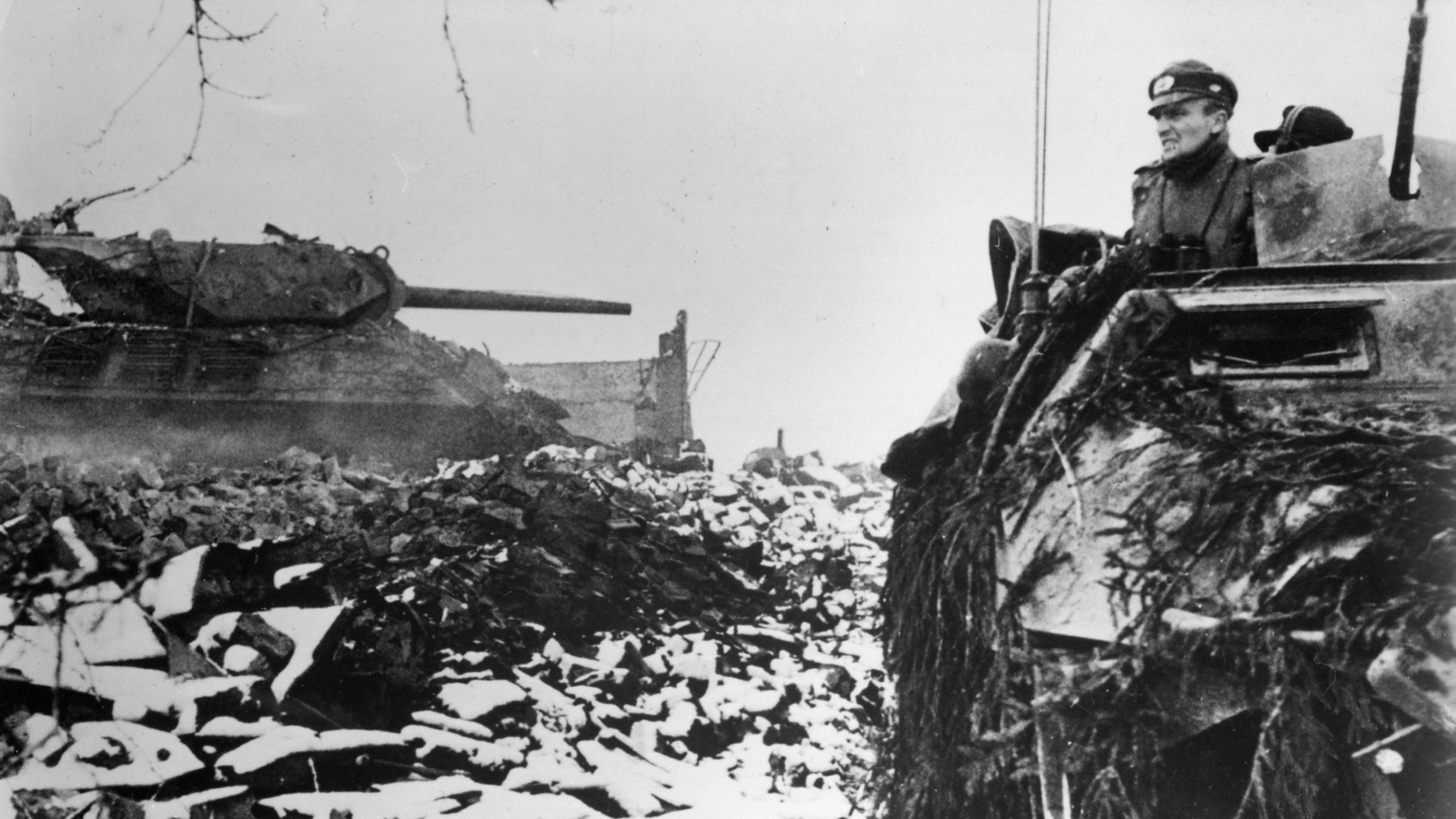
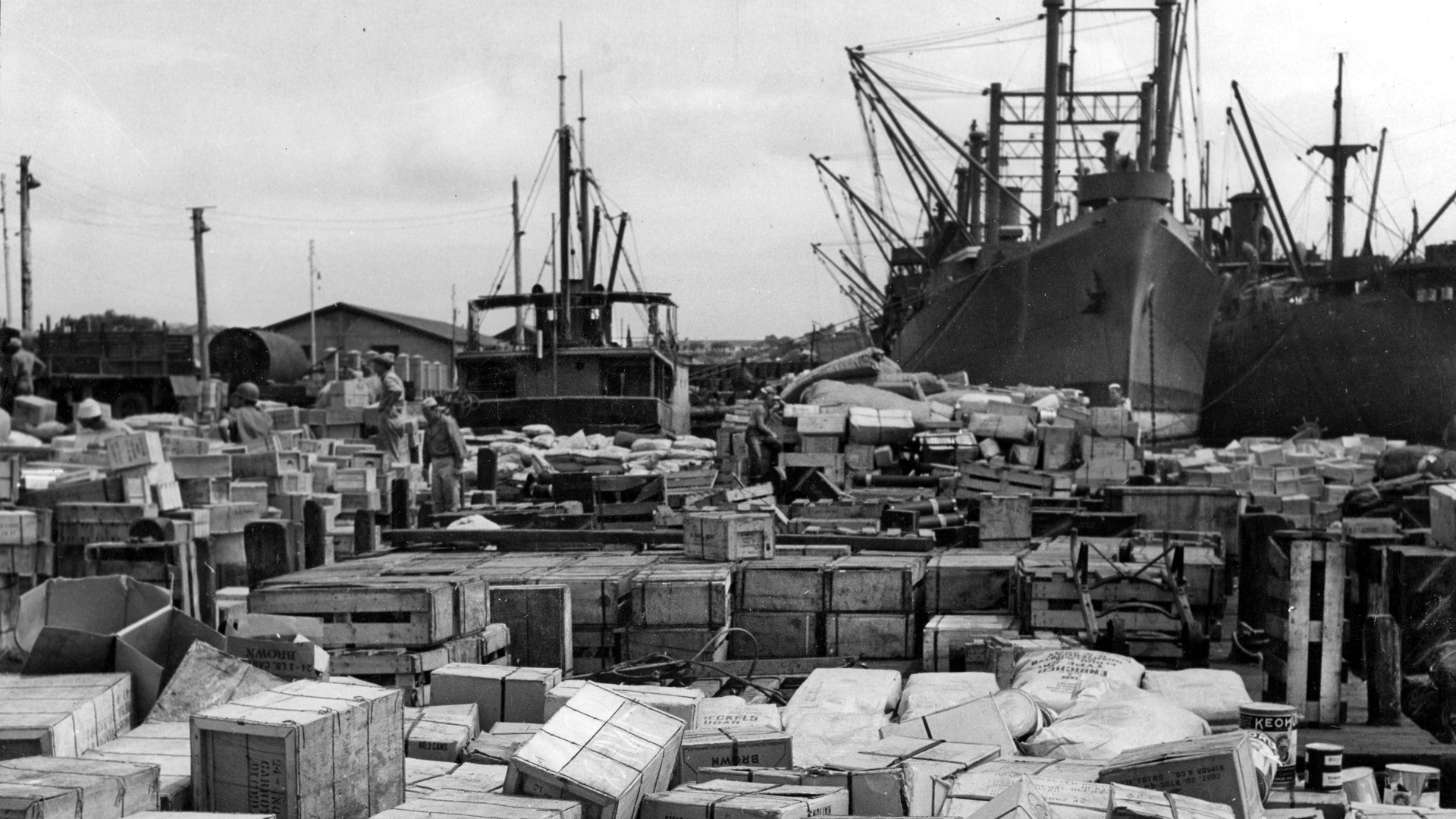
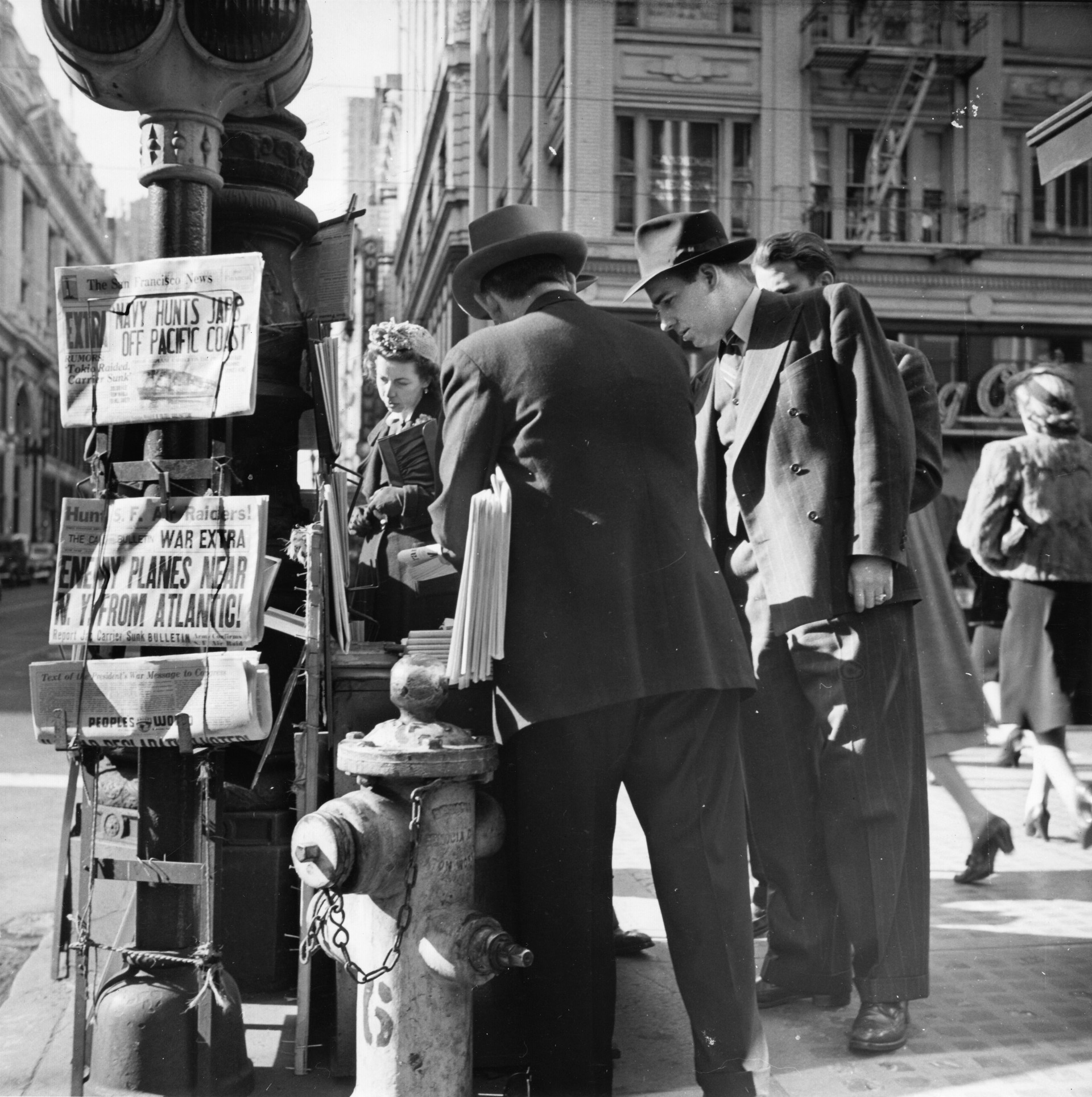
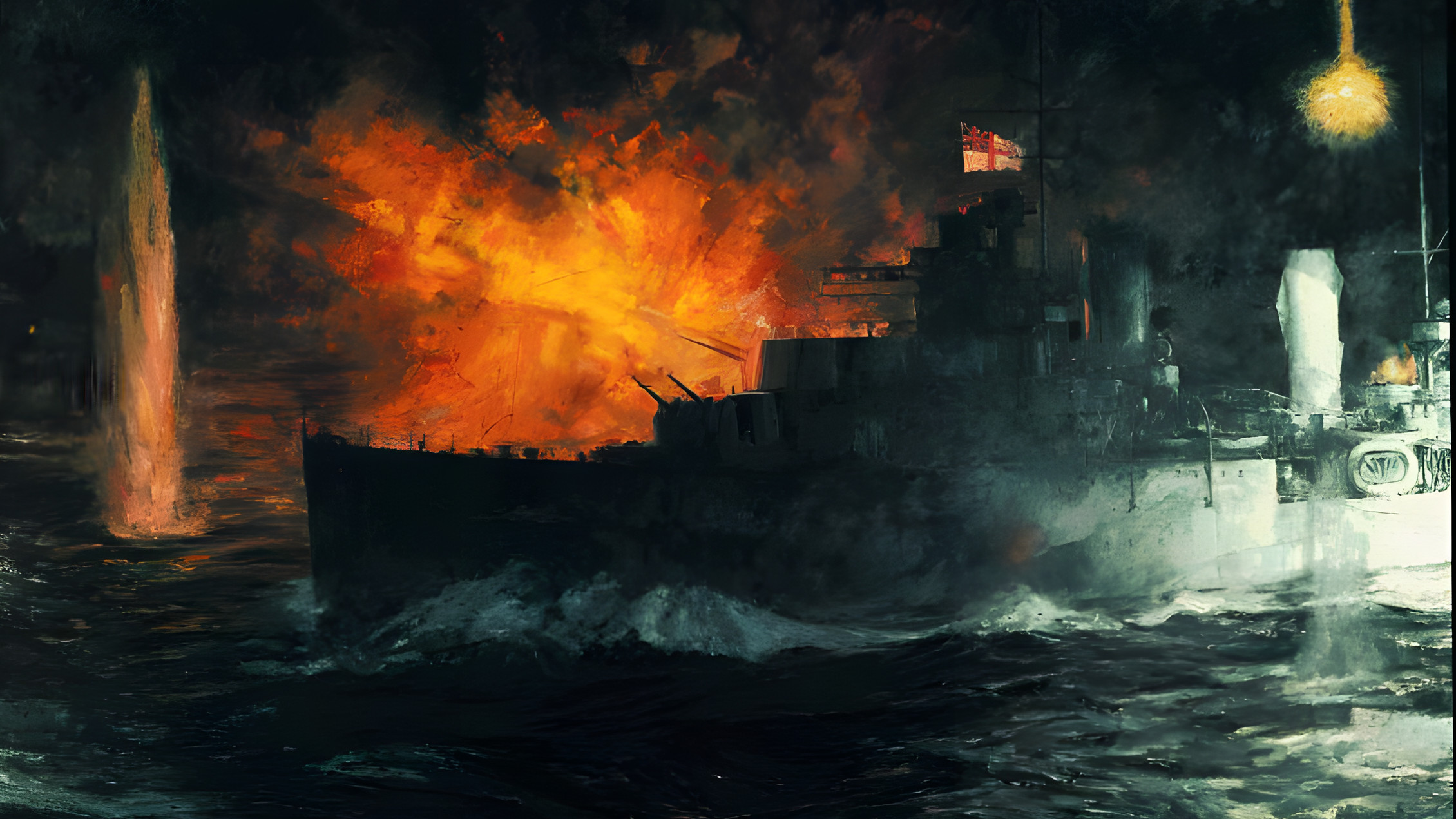
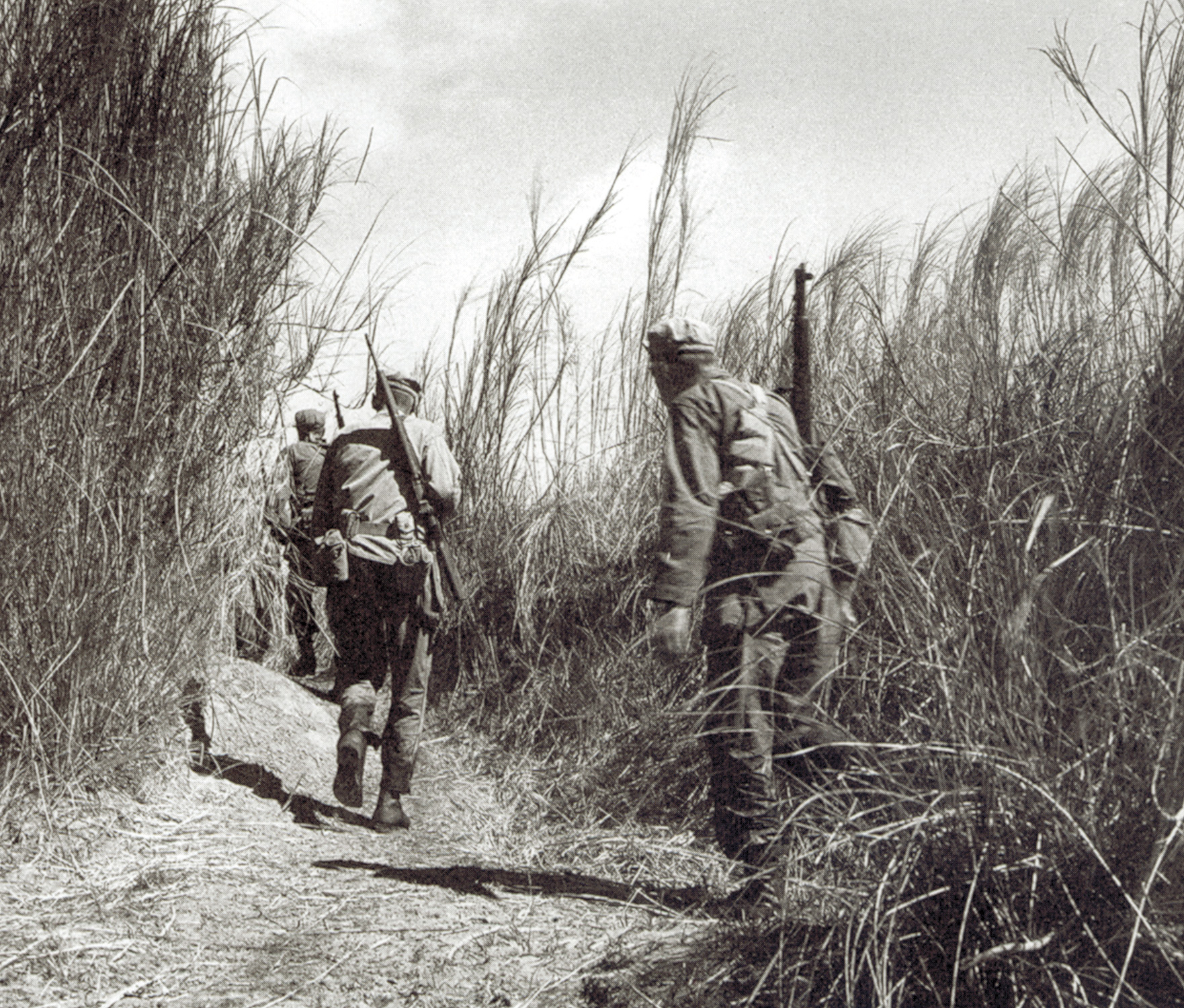
This is absolutely fascinating! I thoroughly enjoyed this article!
Thank you so much for all the information and photos, especially of my native Burbank, I’m glad for it, I’m doing a little art project on the camouflage effort. Do you know of any special nickname given to the Burbank project?
Fascinating that there’s never been a movie on this subject. Really great research, thank you!
Jack Warner was not afraid his soundstages in Burbank would be mistaken for an aircraft factory and targeted by Japanese bombers. In fact, he welcomed it! A large Warner Bros. soundstage that faces Barham Blvd. for years had the word LOCKHEED painted in huge letters above the sliding entry doors to fool the enemy airborne invaders. I wondered about this when I came to Hollywood in 1977. I passed the building almost every day and saw the word HEED over the large sliding entry doors to that particular stage. Subsequently I learned about the patriotic studio head’s bold contribution to the war effort. During subsequent repairs made to the building, the letters LOCK had been covered with new siding, but giant HEED survived for many more years.
Great article never knew about these structures. Got a good education
Super article on our fake cities